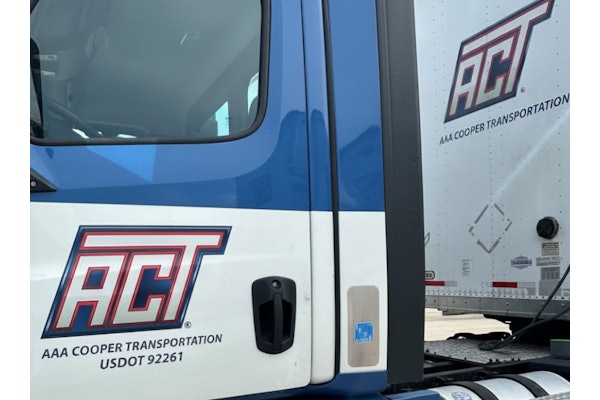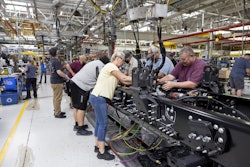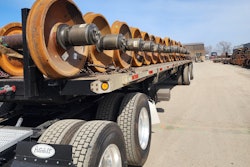The National Highway Traffic Safety Administration likely will finalize its rule establishing a shorter stopping distance by this fall, and implementation could come as soon as 2009, experts say. The new standard – which, like the current one, will involve the braking of the tractor only, tested with a loaded but unbraked trailer behind – could mean the stopping distance will be 30 percent shorter than before.
Today, cars traveling 60 mph stop in 150 to 170 feet, and trucks in about 300 feet. After the change, the distance for trucks will be 230 to 240 feet, which will be “a tremendous improvement,” says Randy Petrish, vice president of technical services at Haldex. That’s because when it comes to truck-car collisions, closing speed and stopping distance are major worries, Petrish says. Bendix Spicer Foundation Brake officials report that NHTSA’s proposal actually calls for a 20 to 30 percent reduction, but the company strongly supports the full 30 percent reduction.
Will this require a revolution in tractor braking systems? Not at all – at least not on twin screw tractors, says Petrish, who explains that some fleets already spec brakes that can do the job. The biggest change will be upgrading front-axle brakes from today’s standard-size 15-inch-diameter drum and 4-inch-wide lining to 16.5 and 5 inches, respectively.
Those brakes will produce double the torque of today’s front-axle brakes, says Paul Johnston, Meritor WABCO’s senior director of compressor and braking. And without criticizing the industry for sticking with 15-by-4 front-axle brakes, Petrish believes this is an overdue change.
What many fleet maintenance managers may not realize is that such a change might not only reduce the company’s safety liability, but also have a favorable overall cost impact by cutting the number of relines needed over a tractor’s life cycle. The change on the front axle would increase the lining volume of a Meritor Q Plus brake from 46 cubic inches to 76 – a 65 percent increase. The drive-axle brake size increase would produce a 24 percent increase in lining volume.
Of course, tractors with single drive axles are likely to need more than better front-axle brakes. “Customers need to be careful not to upset the brake balance between tractor and trailer,” Johnston says. “Trailers are not included in the regulation changes, and there are a lot of existing trailers in the field with current brake systems that will be used with the new tractors.”
The next step in improving front-axle braking would be disc brakes, which Petrish believes are superior in every respect. “There are maintenance advantages because of longer lining life, and they eliminate pull because drums are self-energizing, something that cannot be controlled, while discs are not,” Petrish says. “They offer superior uniformity, consistency and repeatability.” Discs offer the same stopping power throughout the lining’s life, whether hot or cold, which helps balanced braking, Petrish says.
“When you put disc brakes on the front axle and you have proper brake balance, they will actually reduce the wear on other axles of the vehicle, including both tractors and trailers,” Bendix says. Lining life increases 15 to 25 percent, Bendix says.
Once production volumes for disc brakes reach the point where truck OEMs won’t find their use to be inconvenient, the price will come down, Petrish believes.
Keys for maintenance
None of the changes expected in the near future are likely to relieve any maintenance worries for fleet managers. A big concern is proper maintenance of brake adjusters, commonly called slack adjusters. Grease is important because it maintains low friction between mating parts such as gears and sealing surfaces, and also helps keep contaminants out, ArvinMeritor’s experts say.
At installation, make sure to set up the slack according to manufacturer’s instructions – for example, by installing it at the correct angle – so that it will be able to provide the correct adjustment, says Joseph Kay, ArvinMeritor’s engineering manager of brake systems. “The biggest mistake is to manually adjust an automatic slack and assume it is working properly. If a technician finds a brake with a long stroke, then the reason for the problem needs to be determined.” No slack will provide the proper adjustment if the foundation-brake system has worn parts, Kay says.
More care is needed when backing off the slack to remove the drum or service the slack itself, Bendix says. Prevent damage to the anti-reversing clutch on clearance sensing slacks by following the manufacturer’s instructions to back it off. Also, follow greasing instructions – which may involve cleaning the slack first, as well as adjusting it after grease is applied – to fill the mechanism properly.
One perennial issue for all fleets is doing a brake job properly. A careful inspection of all the wearing parts – clevis pins, clips, fasteners, anchor pins, cam rollers, camshafts and bushings – is critical, Kay says: “Replace all suspect components.” Use trusted parts, as deficient parts will quickly put play in the system or fail to enable the brakes to retract properly, resulting in a short life for the brake job, Kay adds.
It’s essential to do both brakes on an axle and ideal to do both axles in a tandem-axle set, or imbalance will cause the new brakes to carry more load than they can handle, Petrish says. It’s also necessary to service S-cam bushings during every reline, not every other one, because of longer lining life, Bendix says; at the very least, check the clearance, and don’t reuse drums because they lose mass to wear, making them less capable of absorbing heat.
As far as brake lining goes, Petrish says to either buy the original OE part or an exact OE service equivalent material, a position echoed by Bendix. An inferior lining on one axle you’ve rebuilt would increase stopping distance and – by increasing the work done by the remaining axles – significantly shorten the life of the other brakes.
Use an air compressor of adequate size, the experts say: Ideal size depends on the number of axles and sizes of brake chambers, as well as the truck’s duty cycle. Run time should be 25 to 30 percent at most, not 50 percent, Petrish says. Also, it’s essential to use quality OEM parts when rebuilding, Kay says, because air compressor wear means oil in the air dryer and deteriorated performance. Using good engine oil and changing it and the filters at proper intervals will extend air compressor life, Johnston says, because engine oil lubes the compressor and will minimize air system leakage so it won’t work as hard.
Both compressor condition and proper installation and maintenance of the air dryer are critical for ABS performance, since the compressor affects the dryer and ABS actuating valves are sensitive even to low levels of moisture, with smaller passages than the foundation brake valves, Petrish says. One of the keys to success here, he says, is a long-enough line between the air compressor and dryer, which should be behind the cab in open air, not in or near the engine compartment. This will cool the inlet air to 150 degrees Fahrenheit or less, critical in allowing the desiccant to remove enough moisture, Petrish says. Also, replace the cartridge once a year, he says.
While brake suppliers are watching NHTSA’s upcoming rule on stopping distance very closely, don’t expect new regulations to affect your maintenance protocols.








